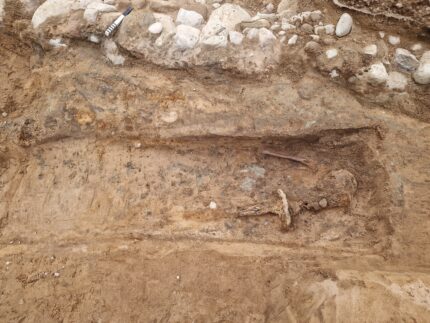 A medieval grave containing the remains of a man more than six feet tall with a sword more than four feet long has been discovered in the port city of Halmstad on Sweden’s west coast. The sword was placed at the man’s left side and was the only artifact in the grave. Osteological examination of the skeletal remains found the man was at least 6’3″ and the surviving parts of the sword, wooden hilt included, are 4’3″ long.
A medieval grave containing the remains of a man more than six feet tall with a sword more than four feet long has been discovered in the port city of Halmstad on Sweden’s west coast. The sword was placed at the man’s left side and was the only artifact in the grave. Osteological examination of the skeletal remains found the man was at least 6’3″ and the surviving parts of the sword, wooden hilt included, are 4’3″ long.
 The burial was discovered at Lilla Torg, a square in the city center that in the 15th century was part of the Franciscan monastery of Sankta Annas. The first excavation at the square in 1932 found the remains of the monastery kitchen and of the church. This year’s excavation found more of the monastery church. The grave with the sword was discovered under the floor of the south nave. Two other graves were found next to him, one belonging to an adult woman, the other to a man.
The burial was discovered at Lilla Torg, a square in the city center that in the 15th century was part of the Franciscan monastery of Sankta Annas. The first excavation at the square in 1932 found the remains of the monastery kitchen and of the church. This year’s excavation found more of the monastery church. The grave with the sword was discovered under the floor of the south nave. Two other graves were found next to him, one belonging to an adult woman, the other to a man.
No other objects were preserved in the three investigated graves. The sword is also the only decommissioned object found in the 49 graves examined so far during the ongoing reconstruction of Lilla Torg. Finding swords in medieval graves is very rare, and the people who were buried with swords belonged to the upper echelons of society. The sword find at Lilla Torg confirms that Sankta Anna’s church was used as a burial place for, among other things, people of noble birth during the 35 years that the Franciscan order operated on the site.
The sword has been removed from the ground and sent to conservation to begin examination and treatment of the find in a protective environment. The first X-ray image of the find shows that the blade is decorated with two inlaid crosses, probably in precious metal. Already when the sword was found, the field archaeologists could guess that the blade was decorated, something that the X-ray image has now confirmed.
Halmstad received its first town charter in 1307 and its current historic center was established in the 1320s. It was part of the Kingdom of Denmark at that time. The Sankta Annas monastery, built between 1494 and 1503 with the aid of a donation of an expensive silver plate from Christina of Saxony, then Queen of Denmark, had a brief life. It was shut down by the city magistrate in 1531 and the property repurposed to various uses including as a hospital and an armory. What was left of the monastery burned down in a 1619 fire that destroyed much of the town.
